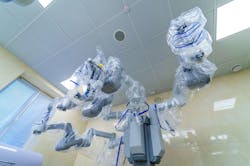With all the talk in the industry about medical robots, it is best to first define what that really means. For starters, there aren’t actually autonomous robots that duplicate human decision making and fewer still that are semi-autonomous. However, there are medical bionic constructs in use today optimizing healthcare providers’ performance through electronic or electromechanical devices.
The distinction worth noting here is that these medical constructs and devices facilitate and increase the abilities of the user, but do not replace them.
Unfortunately, it’s likely too late to change the vernacular to something more fitting. Despite all the semantics, there is an important distinction that is key to design and development processes. In this article, we will explain two very important reasons why this distinction is critical.
The first reason involves regulatory strategy because it can significantly change depending on what kind of device is selected, especially when it comes to the level of autonomy, team usability validation and training. The second reason is in the understanding that these systems are an extension of a clinician’s current ability and facilitates activities that they may be done manually. It can, therefore, make a substantial impact on the user interface design and development.
Strategic Regulatory Impact
Many robotic systems today are based on technology that could facilitate a procedure autonomously. Validating the safety and efficacy for FDA approval would be cost-prohibitive. The proof would involve having to demonstrate the robot safely managing contingencies, which can be unpredictable. Validation trials of a scale similar to pharmaceutical clinical trials would be required and involve hundreds, if not thousands of patients.
Unlike a medication—typically a high-volume consumable which is reimbursed by a payee—a piece of capital equipment that is marketed to a healthcare facility does not offer the same ROI that could justify such a validation investment. Nevertheless, by having the clinician remain in control and the system consigned to an extension of their abilities, the human maintains responsibility for the result.
Maintaining the clinician as the decision-maker helps the validation process remain a function of the clinician’s interaction with the robotic system’s user interface. This means the user’s clinical abilities are not to be validated—only the robotic system met expectations for efficacy, safety and performance. That said, both the design and usability validation can involve a lot more complexities than other medical devices.
Surgical Workflow Considerations
A surgical robotic system can be considered an extension of the surgeon’s abilities and can impact the rest of the surgical workflow as well as all the other actors involved in the surgical procedure. With conventional surgery, whether it be open or laparoscopic, typically interactions between a team of clinicians are well orchestrated. The team usually comprises a lead surgeon, first assist, sterile nurse/tech, circulating nurse, anesthesiologist and possibly others (e.g., perfusionist), or duplicates of some of the actors listed. When it is a teaching hospital, interns and fellows may also be on the team.
The reason we need clear understanding of the roles of all the people involved, especially when introducing a new robot into the operating room, is to help achieve a favorable outcome for the patient. For instance, it can impact the manner in which the lead surgeon interacts with the team, especially if the robotic system’s physical footprint requires some space in an already congested environment. Moreover, the team dynamics can be profoundly impacted if the team leader is isolated from the rest of the team and instead resides in a control console as part of trying a different team configuration.
Role of Communication in Different Scenarios
Even though the intention is to make the robot an optimized instrument for the surgeon, the surgeon’s responsibilities and those of his extended surgical team can be greatly affected. For example, many surgical procedures require a sequence of different end effectors such as cameras, grippers, cutting forceps, surgical glue dispensers and blunt dissectors.
Even switching tools for robot-assisted minimally invasive surgery can require time-consuming removal and replacement. For such procedures, team members must interact with each other and the robot, while often the lead is interacting with them without face-to-face communication. Obviously, this can cause an added complexity because a substantial amount of the communication during many procedures is non-verbal. Granted, while the actors are wearing masks, they have learned to read body posture and facial expressions inclusive of the mask.
Such team dynamics requires consideration, and when it comes time to validate the user interface of the robotic system, the team should be included in the validation test. Moreover, depending on the type of healthcare facility, such as a teaching hospital or private institution, teams may or may not be cohesive with seasoned versus new members on the team. This is another important consideration for usability validation in which both team types should be involved in evaluating the design. Importantly, upstream usability engineering research must be conducted to inform the design and regulatory team of the requirements for future validation based on well understood use-related risk assessments (URRA).
Impact of Various Modes of Training
The URRA can impact training models for the robotic system, another regulatory path strategy which further complicates risk mitigation and the subsequent validation.
Traditional surgical devices that are usually manually operated typically do not require formal training. That is, training beyond orientation or an “in-service.” There is a difference between orientation and formal training. Orientation is not considered a risk mitigation from a regulatory perspective. When a design control like training is a risk mitigation, robust documentation is required to demonstrate to the regulatory bodies the degree of control and repeatability that the manufacturer maintains.
Under the design control process, there is a protocol for how the trainer is trained, a record of who was trained, when they were trained and if and when subsequent training is required as well as required qualifications the training results in during the use of the system. The definition of “system” may include the robot proper, the control console, the robot drapes and the end effector’s instrument attachments. Additionally, it often includes the cleaning and reusability of the instrument attachments. Obviously, formal training is a far greater and ongoing burden and responsibility on the manufacturer.
User Interface Design Impact
Team dynamics, along with the introduction of a robotic system into a surgical procedure, can have comparable influence on the regulatory impact regarding the design and development of all the system’s user interfaces—both virtual and physical. The same user research insights that can inform the URRA and regulatory strategy apply to the design and development of the robotic system’s user interface.
For instance, for the lead surgeon’s user interface, it is important to first understand the likelihood of negative and positive transfer bias in the physical user interface. The same applies to the system’s cognitive load requirements, especially if the system is expecting the surgeon to be responsible for what was previously a team effort. Then, there is the accommodation of team dynamics and communication to consider, as was explained earlier. These considerations also apply to the other user interfaces such as end effector access to the anatomy, instrument attachment and draping.
Positive/Negative Transfer Biases
Revisiting the surgeon’s user interface example and the associated biases, the mode in which the surgeon executes a procedure manually, the variety of instruments available for use and their specific user interfaces, the instruments’ capabilities, kinematics and feedback can result in either a positive or negative transfer bias depending on how the new control interface is designed.
Negative transfer bias can present a possibly dangerous condition and user error that could lead to harm. It can change the rote manner in which a task is performed relative to how it was learned and practiced previously, be it another robotic interface or conventional procedures.
Conversely, the user interface design can bring positive transfer bias by emulating or carefully transitioning from a normal behavior and interface to the new user interface and workflow experience. It is not a viable strategy to depend on training to convert the user’s previously learned skills and behavior. A proactive and robust approach would be to do the due diligence in understanding the user’s expectation and aspiration and achieve an in-depth understanding of the perceived attributes that afford the intended behavior.
Sean Hägen is founder and director of research and synthesis, BlackHägen.



